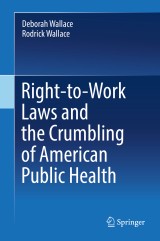Details

Right-to-Work Laws and the Crumbling of American Public Health
|
53,49 € |
|
| Verlag: | Springer |
| Format: | |
| Veröffentl.: | 16.02.2018 |
| ISBN/EAN: | 9783319727844 |
| Sprache: | englisch |
Dieses eBook enthält ein Wasserzeichen.
Beschreibungen
<p>This book discusses the socioeconomic effects of Right-to-Work (RTW) laws on state populations. RTW laws forbid requiring union membership even at union-represented worksites. The core of the 22 long-term RTW states was the Confederacy, cultural descendants of rigidly hierarchical agrarian feudal England. RTW laws buttress hierarchy and power imbalance which unions minimize at the worksite and by encouraging higher educational attainment, social mobility, and individual empowerment through group validation. Contrary to claims of RTW proponents, RTW and non-RTW states do not differ significantly in unemployment rates.</p><p>RTW states have higher poverty rates, lower median household incomes, and lower educational attainment on average and median than non-RTW states. RTW states on average and median have lower life expectancy, higher obesity prevalence, and higher rates of all-cause mortality, early mortality from chronic conditions, child mortality, and risk behaviors than non-RTW states. The higher mortality rates result in startlingly higher annual numbers of years of life lost before age 75. Stroke mortality at age 55-64 in RTW states results in nearly 10,000 years annually lost in excess of what it would be if the mortality rate were that of non-RTW states.</p><p>A review of respected publications describes the physiological mechanisms and epidemiology of accelerated aging due to socioeconomic stress. Unions challenge hierarchy directly at work-sites and indirectly through encouraging college education, social mobility, and community and political engagement. </p><p> </p><p>How startling that feudal hierarchy lives in 21<sup>st</sup> century America, shaping vast differences between states in macro- and micro-economics, educational attainment, innovation, life expectancy, obesity prevalence, chronic disease mortality, infant and child mortality, risk behaviors, and other public health markers! Readers will gain insight about the coming clash between feudal individualism and adaptive collectivism, and, in the last chapter, on ways to win the clash by “missionary” work for collectivism.</p><p></p>
<div>The Post WWII America and the High Point of Union Participation.- What Unions Do for Workers.- Social and Economic Measures Nationally and by RTW Status.- Social and Economic Differences: RTW and non-RTW States.- Measures of Death.- Early Mortality from Ischemic (Coronary) Heart Disease.- Premature Unspecified Stroke Mortality.- Obesity and Diabetes.- American Child Mortality and Low-Weight Births.- Taking Risks.- Resilience.- Data Sources.- Index.</div>
<b>Deborah Wallace,</b> Volunteer Research Scientist, NY State Psychiatric Institute at Columbia University, Division of Epidemiology<div><b>Rodrick Wallace</b>, Research Scientist, NY State Psychiatric Institute at Columbia University, Division of Epidemiology</div>
<p>This book discusses the socioeconomic effects of Right-to-Work (RTW) laws on state populations. RTW laws forbid requiring union membership even at union-represented worksites. The core of the 22 long-term RTW states was the Confederacy, cultural descendants of rigidly hierarchical agrarian feudal England. RTW laws buttress hierarchy and power imbalance which unions minimize at the worksite and by encouraging higher educational attainment, social mobility, and individual empowerment through group validation. Contrary to claims of RTW proponents, RTW and non-RTW states do not differ significantly in unemployment rates.</p>RTW states have higher poverty rates, lower median household incomes, and lower educational attainment on average and median than non-RTW states. RTW states on average and median have lower life expectancy, higher obesity prevalence, and higher rates of all-cause mortality, early mortality from chronic conditions, child mortality, and risk behaviors than non-RTW states. The higher mortality rates result in startlingly higher annual numbers of years of life lost before age 75. Stroke mortality at age 55-64 in RTW states results in nearly 10,000 years annually lost in excess of what it would be if the mortality rate were that of non-RTW states.<p></p><p>A review of respected publications describes the physiological mechanisms and epidemiology of accelerated aging due to socioeconomic stress. Unions challenge hierarchy directly at work-sites and indirectly through encouraging college education, social mobility, and community and political engagement.</p><p>How startling that feudal hierarchy lives in 21<sup>st</sup> century America, shaping vast differences between states in macro- and micro-economics, educational attainment, innovation, life expectancy, obesity prevalence, chronic disease mortality, infant and child mortality, risk behaviors, and other public health markers! Readers will gain insight about the coming clash between feudal individualism and adaptive collectivism, and, in the last chapter, on ways to win the clash by “missionary” work for collectivism.</p>
Unique resource assessing the public health impact of right-to-work laws Provides qualitative and quantitative comparisons of socioeconomic system functioning of right-to-work and non-right-to-work states Creates a blueprint for climbing out of the looming crisis of extreme hierarchy and public health erosion

















